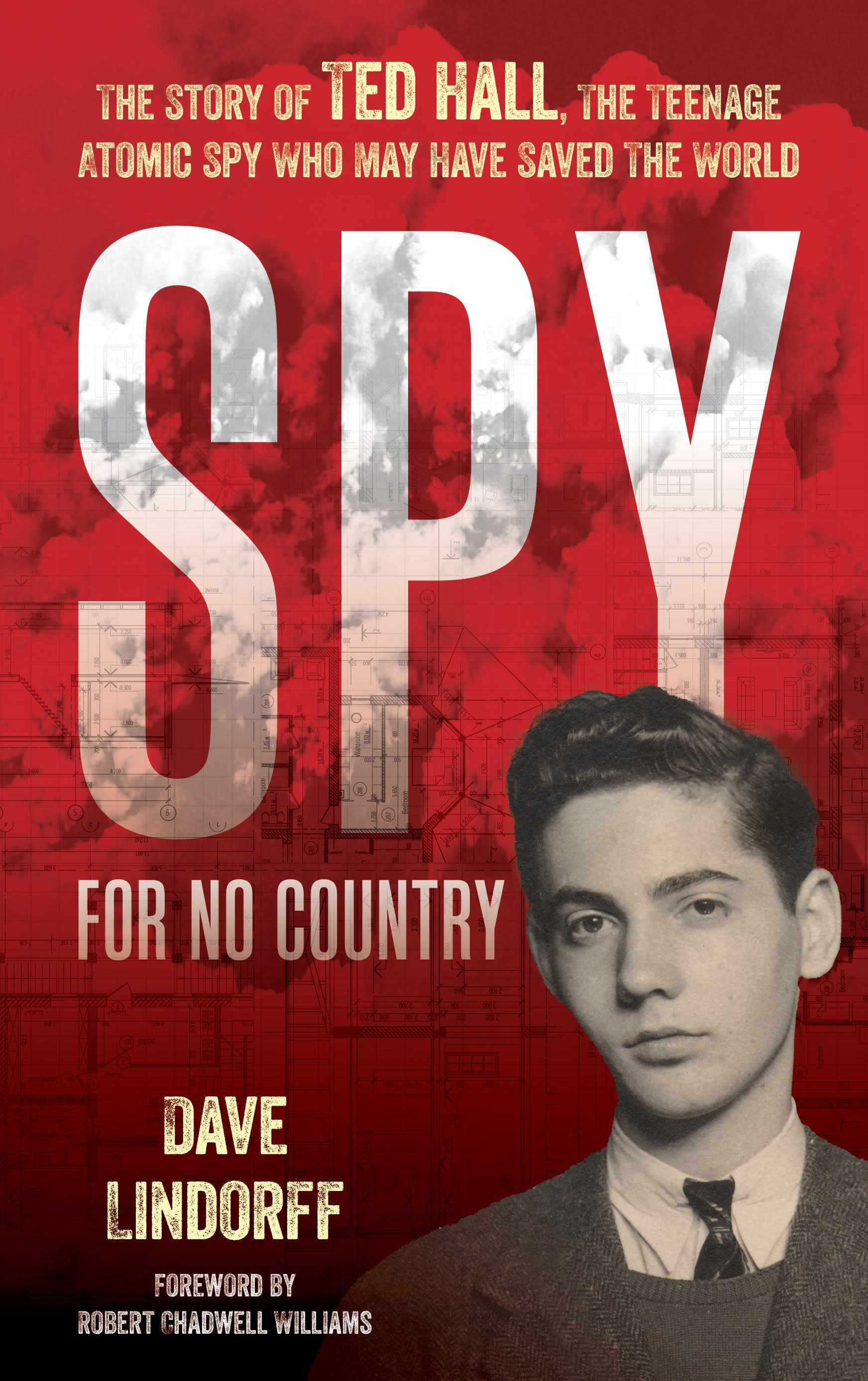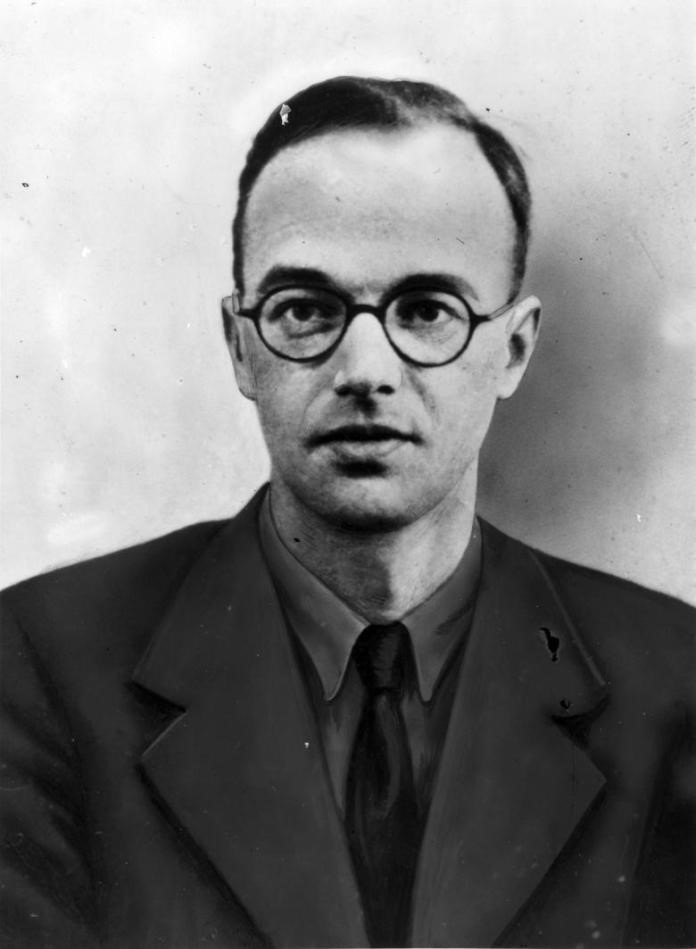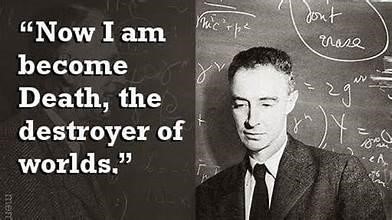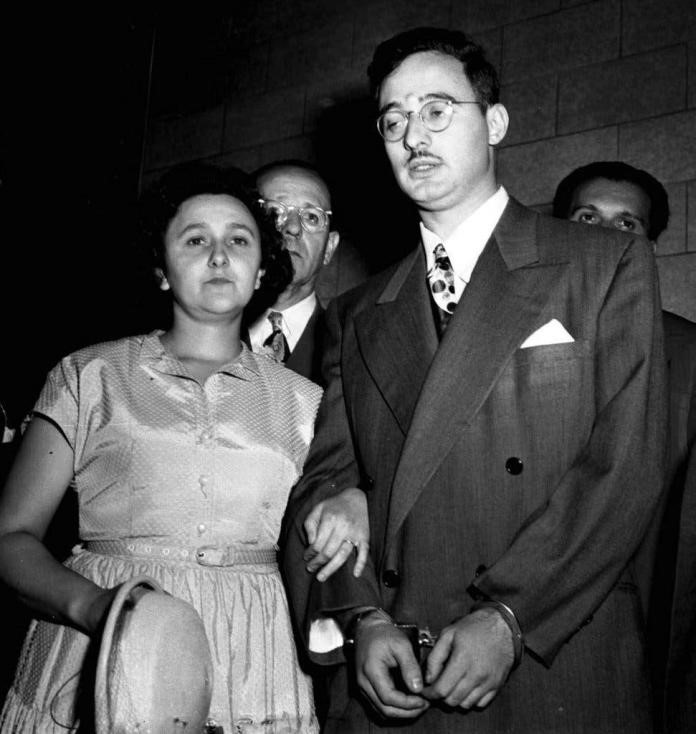 |
RONRIDENOUR.COM |
 |
RONRIDENOUR.COM |
| Home |
| About Ron Ridenour |
| Articles |
| Themes |
| Poems |
| Short stories |
| Books |
| Links |
| Search |
| Contact |
| Dansk |
| Español |
Spy for Humanity Saved the World from a U.S.
Planned Nuclear War: Ted Hall Deserves a Nobel Peace Prize
[October 30, 2023]
Ted Hall Helped the Soviet Union to counterbalance the U.S. monopoly
on atomic weaponry after World War II, which acted as a deterrent against
aggressive U.S. war plans.

Dave Lindorff initiated the2023 documentary film A Compassionate
Spy, following a correspondence with Ted Hall’s 87-year-old
widow, Joan Hall.
Lindorff had written an article in 2017 proposing Ted Hall and Klaus
Fuchs be granted the Nobel Peace Prize for sharing vital information
about the atomic bomb development under way in Los Alamos, New Mexico—the
Manhattan Project—in the mid-1940s.[1]
Joan Hall wrote to Lindorff:
“I’m reading your article about Ted Hall with tears
in my eyes. I’m Ted’s widow, and you are the first person
who ‘got’ him.”
Dave lives in Philadelphia, and Joan lived in Newnham, a village just
outside Cambridge, England. They became email and phone friends until
in 2018 when he and his musician wife Joyce had occasion to spend a
few days with her in her home.
Dave told Joan he thought it was time for a new book on Ted’s
spying as it was clear from released national security documents from
the late ‘40s and early ‘50s that the Truman administration
had been planning a massive first strike attack on the USSR. Truman
dropped the idea after the Soviets exploded their first nuke in August
1949, thanks to the spying by Ted Hall and Klaus Fuchs.

Karl Fuchs. He also deserves the Nobel Peace Prize
Joan said she preferred that Dave could do a film. Not being a filmmaker,
Dave was unwilling to embark on such a project. He reached out to film
documentarian Steve James, whom he had met playing an on camera reporter
role in an earlier James documentary, “Small Enough to Jail.”
James liked the idea, and they put together a team with James as director
and his usual producer Mark Mitten and Dave as co-producers, to create
“A Compassionate Spy,” which this reviewer saw during the
Cambridge film festival, November 2022.
The idea to do a book became clearer during the film-making process.
Lindorff has just had his book published: Spy For No Country: The
Story of Ted Hall, the Teenage Atomic Spy Who May Have Saved the World
(Prometheus Books, October 2023).
Three hundred pages of prodigious and impeccable research later, there
is no doubt that physicist Ted Hall (and Karl Fuchs) does deserve a
Nobel Peace Prize for delivering vital information to the Soviets so
that the ever-marauding United States could not exclusively possess
the atomic bomb. Beyond sole possession, Ted, and a handful of other
spy-couriers, prevented genocidal holocausts planned by the U.S. in
1950-1.
 Director
Steve James, Joan Hall, and Dave Lindorff in Joan’s home. The
Peace Lily is from photographer Jette Salling and me to symbolize the
Nobel Peace Prize Ted should have been awarded. [Source: Photo courtesy
of Jette Salling]
Director
Steve James, Joan Hall, and Dave Lindorff in Joan’s home. The
Peace Lily is from photographer Jette Salling and me to symbolize the
Nobel Peace Prize Ted should have been awarded. [Source: Photo courtesy
of Jette Salling]
If Barack Obama—seven-wars-at-one-time president—could understand, as did one president, John F. Kennedy, that the U.S. has nearly always been an aggressor nation under the guise of Pax Americana, he should turn over his undeserved Peace Prize to Ted Hall’s family. (According to official data, the U.S. has conducted approximately 350 wars, not counting CIA covert actions/regime changes/assassinations of scores of national leaders.)
Spy For No Country reads like a detective mystery and a romance novel. No, Ted Hall did not spy for any country, rather for humanity, all eight billion of us. Today, this is the most important book for everyone to read, especially in the West. Then take the book to your protests before their house-of-cards governments and shut down their annihilator nuclear weapons, and stop the current proxy war against Russia.
Remember that the U.S. with Britain, France, Czechoslovakia, Canada
and Japan invaded the new revolutionary Russia in 1918 while U.S.-Britain-France
were at war against Germany. Pax Americana superiority ideology has
since aimed to dominate the world.
Ted Hall and Klaus Fuchs—an older experienced Manhattan Project
scientist who also delivered vital information to the Soviets without
either knowing the other—did so, believing that two rival nations
with the bomb could lead to its being banned, or at least could prevent
its use again.
Unbeknownst to them, their fears were warranted even before the end
of the World War II when the Soviet Union was allied with the U.S./UK.
Already in July 1945, Prime Minister Winston Churchill planned a nuclear
surprise attack (Operation Unthinkable) against several key
Soviet cities, and then aimed to conquer their “ally.” President
Harry Truman postponed the idea since he needed more bombs other than
just the two they had, which were then ready to drop on Hiroshima and
Nagasaki.
Elder folk may remember that the United States openly threatened to
attack the USSR with nuclear bombs during the Berlin Blockade in 1948.
Families built bomb shelters. Schoolchildren had to go through nuclear
attack drills. Soon, millions protested against nuclear war. The Nuclear
Freeze campaign began in the U.S., England, and much of Europe.
What was not public information was the U.S.’s first-nuclear-strike
plans already in process.
“During 1946-1950, as President Harry Truman’s new and vastly
better-funded and more powerful Central Intelligence Agency (CIA), quickly
shifted the focus of U.S. intelligence activities from Germany and Japan
to the Soviet Union, which became America’s new apex enemy. During
those years, in secret, Truman and his team of CIA, National Security
Council advisers, and Pentagon strategists, as well as arms industry
lobbyists, worked on plans to use America’s new superweapon, the
atomic bomb,” Lindorff writes.
“From the moment the United States had its bomb, operational plans
for a first strike on the Soviet Union were drawn up with grisly names.
Pincher (developed in June 1945, before World War II had even ended
and at a time when the United States had, at most, nine bombs), Broiler
(March 1948), Bushwhacker (1948), Frolic (May 1948), Sizzle (December
1948), Trojan (January 1949), Shakedown (October 1949), and Dropshot
(1949–1959).”
Illustration from A Compassionate Spy of nuking 200 targets at 100
Soviet cities shows that United States/Americans would have annihilated
several million human beings and conquered the rest. [Source:
A Compassionate Spy]
[Source:
A Compassionate Spy]
Dropshot was updated throughout the 1950s, with each revision featuring
more targets and more nuclear bombs, including hydrogen bombs 500-1000
times more destructive than atomic ones.
What put a thunderous halt to the U.S.’s planned genocidal attack
was the surprise on August 29, 1949, when the Soviets tested their atomic
bomb, which was based on Ted Hall and Klaus Fuch’s information
that they gave the Soviets. Truman, the U.S.’s intelligence apparatus,
Pentagon strategists and nuclear scientists were stunned. They had not
expected the Soviets to get their own bomb before 1953 or 1954.
Dave explains how this happened, based upon extensive research and interviews,
including interviewing Michael Peck, author of America’s Cold-War
Master Plan to Nuke Russia (2015):
“For the first time, we know which Russian cities would have been
destroyed, and why. The U.S. government has finally declassified the
1950s Strategic Air Command target list…SAC [USAF Strategic Air
Command] listed [in 1956] over 1200 cities in the Soviet bloc, from
East Germany to China, also with priorities established….deliberately
included civilian populations…including all ‘population’
in all cities, including Beijing, Moscow, Leningrad, East Berlin and
Warsaw.”
Bear in mind the suffering the Soviet people endured during World War
II. Russia, the major victor of the European war, lost 27 million people
(13% of its population). UK lost 450,000 (1%). The U.S. lost 300,000
(1/3 of 1%).
In Ukraine, German Nazis and Ukrainian fascists murdered 1.2 million
Jews, hundreds of thousands of Poles and ethnic Russians. Some of the
Ukrainian fascists’ descendants are a main neo-fascist military
force fighting Russians today. Their World War II hero, Stepan Bandera,
is also Zelensky’s hero, even though he was born a Jew.
Daniel Axelrod, co-author with Michio Kaku of To Win a Nuclear War,
told Lindorff:
“Americans have been told for decades that having nuclear weapons
has been entirely defensive… ‘We’ve learned much more
about how Washington intended to use its nuclear monopoly and clearly
that defense-only story…is just not true…To the extent that
Ted Hall’s passing of information helped hasten the Soviet A-bomb,
one can easily argue that his action actually helped prevent the start
of a second nuclear war in the late 1940s and early 1950s.’”
Lindorff writes: “The Joint Chiefs of Staff at the War Department
had approved a first-strike policy in dealing with the Soviet Union
on July 19, 1945, just three days after the successful Trinity Test,
while World War II was still on and the USSR was a key U.S. ally. This
policy, JCS1496, called for ‘striking the first blow in a nuclear
war.’”
Kaku and Axelrod wrote that the chiefs of staff “informed
the Pentagon that the U.S. must build 400 atomic bombs by Jan.
1, 1953…that 100 of these bombs eventually reaching their targets
could implement the concept of, ‘killing a nation.’”
Killing Russians and Confiscating the Country is Still U.S.
Goal
“The U.S. military began to forecast ‘A-Day’—the
last foreseeable opportunity for the U.S. to mount an attack without
risking direct retaliation, the day of reckoning between the U.S. and
the Soviet Union. The NSC [National Security Council] placed A-Day in
1954.
“The Soviets had their first hydrogen bomb on August 12, 1953.
It was probably not the result of stolen information about the U.S.
bomb. The Soviet thermonuclear bomb was based upon a completely different
design worked out by Soviet physicist Andrei Sakharov.”
Nevertheless, the A-Day concept still exists, despite internationally
acknowledged “Mutual Assured Destruction” (MAD). President
Dwight Eisenhower complained about such expensive waste in his departing
letter to the nation, stating it would be better to use funding for
building schools and hospitals instead of building rockets, planes,
ships, submarines, warheads and bombs.
Truman, realizing that the U.S. could not have sufficient nuclear bombs
to succeed in destroying hundreds of planned targets without the deaths
of “too many” U.S. Americans, stopped the plans just before
leaving office in January 1953. Nevertheless, the public cannot know
what first nuclear strike plans Wall Street weapons industry-Pentagon-CIA
might launch in the future.
Although the current U.S./NATO/Ukraine proxy war against Russia has
brought the world closer than ever to a nuclear disaster—a similar
threat during the 1962 Cuban Missile Crisis—nearly eight decades
have passed, proving that a handful of humanitarian spies have so far
prevented another use of atomic bombs.
Ted’s Epic Decision
Theodore Alvin Holtzberg was born on October 20, 1925, in Queens, New
York, the youngest child of a Russian Jewish father, Barnett “Barney”
Holtzberg, who had immigrated to the U.S. during the last years of Russian
Tsar Nicholas II, and a U.S.-born mother, Rose Moskowitz, the daughter
of Eastern European Jewish immigrants. In addition to Ted, there had
already been daughters Frances and Selma, followed by Edward Nathaniel,
who was eleven years older than Ted.
Ed and Ted were aware of the rise of Nazism with its virulent anti-Semitism
in the United States. Ed, who personally experienced how difficult it
was for Jews to get a decent job, decided to legally change both his
and Ted’s surname to the more Anglo-Saxon “Hall.”
Both boys were brilliant and excelled in school. Ted was also athletic
and musical. Socialist ideals appealed to him as they did for many youth
and unionists in the 1930s.
In 1940, at 14 Ted was already a freshman in Queens College. Brother
Ed enlisted in the U.S. Army Air Corps that year. He earned his master’s
degree in aeronautical engineering after the war. By the mid-1950s,
Ed had become director of the Pentagon’s solid-fuel rocket development
program and later headed the Air Force’s ballistic missile program.
He was recognized as the U.S. Air Force’s top rocket engineer
during that period.
Ted grew bored at Queen’s, and applied to Harvard to pursue his
interest in physics. Aside from their studies, many students were active
against racism, equality for all, social welfare and the New Deal, as
was Ted. He and friend Saville Sax were in a John Reed club, so named
after the radical journalist who supported the 1914 Mexican Revolution
and the 1917 Russian Revolution.

Saville Sax
In the 1943 fall term, Ted was recommended to a recruiter dispatched
by Robert Oppenheimer, science director of the Manhattan Project. At
age 18, he arrived at Los Alamos in January 1944. Once there, he first
learned what the project was all about: Scientists would be working
on one of the two concurrent programs to develop an atomic bomb.
Lindorff wrote that Hall was already “found himself thinking, without any outside prompting, about the need for the United States to share with the Soviets whatever secret weapons the country (and he himself) might be working to create.”
When Ted told Saville about the new job, he encouraged Ted to share
information with the Soviets. Beginning in October 1944 Saville helped
Ted contact Soviets in New York City and was a courier for some time
until Lona Cohen replaced him.
“President Harry Truman and his key advisers were anxious to put
the bomb to use before Japan spoiled things by surrendering, which the
country’s emissaries were reportedly desperately attempting to
do,” Lindorff wrote.
Truman knew Japan had not begun to build an atomic bomb. His goal was
something else, as General Leslie Groves stated during a gathering with
some scientists: “You realize, of course, that the whole purpose
of the Project is to subdue the Russians.”
Generals Dwight Eisenhower, Douglas MacArthur, and Curtis Le May told
Washington there was no need to nuke Japan, because nearly all major
cities and military objectives had already been destroyed with conventional
and firestorm bombings.
After murdering Japanese civilians with nucelar radiation, Truman lied
to the world that the atomic bombs were needed to save thousands of
U.S. American soldiers.
Joseph Stalin had promised FDR at Yalta, February 1945, that the Soviet
Union would aid the U.S. in Japan once the European war ended. Stalin
declared war on Japan two days after the Hiroshima bombing.

The Big Three at Yalta Conference
Stalin sent a million troops into Korea and Manchuria, crushing Japan’s
Kwantung Army. Truman wanted to nuke Japan before Soviet troops could
help win a quick victory, and to frighten the Soviet Union into submission.
Soviet troops were a major cause that the Japanese Emperor surrendered
within the week.
Following the Trinity Test, Robert Oppenheimer, who became known as
the “father of the atomic bomb,” later quoted from a Hindu
scripture: “Now I am become Death, the destroyer of worlds.”

In fact, he was the key author of killing nearly half the 350,000 people
living in Hiroshima, and around 75,000 on August 9 died in Nagasaki.
About 100,000 more died after suffering months and years from radiation.
Thousands more lived on in agony.
Leo Szilard, who urged his former teacher Albert Einstein to convince
President Roosevelt that he should establish a project to develop the
atomic bomb, wrote an impassioned appeal to Truman a day after the Trinity
Test urging him not to use it on Japan. Seventy Los Alamos scientists
readily signed onto it. General Groves refused to send it. Truman would
have ignored it anyway. The same day Szilard sent out his appeal, the
uranium bomb was on its way for use three weeks later.
While U.S. scientists were making the most lethal weapon ever, allegedly
to be used against Nazi-Fascists in Europe, elements in the U.S. ruling
class had illegally and treacherously helped fuel the rise in the 1930s
of Hitler, Mussolini, and Francisco Franco in Spain.
These wealthy pro-fascist plotters opposed FDR’s New Deal so much
that they prepared a “regime-change” operation/coup. The
conspirators, whose families still own much of many countries’
economies, included: J.P. Morgan bankers/arms industry, Rockefeller
oil, Henry Ford, General Motors, DuPont, IBM, Bethlehem Steel, U.S.
Steel, AT&T, General Electric, and other large corporations. Senator
Prescott Bush, grandfather and father to two presidents, was among those
who even gave Hitler credit for war machinery they delivered expecting
that he would win the war, and they would shape the U.S. into a fascist
state ally.
 Henry
Ford received the highest medal Nazi Germany could award a foreigner,
the Grand Cross of the German Eagle, July 30, 1938. Hitler declared:
“I regard Henry Ford as my inspiration.”
Henry
Ford received the highest medal Nazi Germany could award a foreigner,
the Grand Cross of the German Eagle, July 30, 1938. Hitler declared:
“I regard Henry Ford as my inspiration.”
IBM founder Thomas John Watson received the Order of the German Eagle
(2nd class) in June 1937. General Motors chief executive for overseas
operations, James Mooney, was awarded the Order of the German Eagle
(1st class) by Hitler in 1938. J.P. Morgan agent Grayson Murphy was
decorated by Mussolini with the “Order of the Crown of Italy,”
Commander Class, for his role in syndicating Morgan loans to fascist
Italy. [See chapter 8 in my book, The Russian Peace Threat: Pentagon
on Alert (New York: Punto Press, 2018)]
These mass murdering traitors were “dedicated civil servants”
for “American Philanthropists,” the John and Allen Dulles
brothers extolled. Yet President Roosevelt wrote otherwise about them
to his confidant, Colonel Edward House, on November 22, 1933: “As
you and I know, this government has been owned by a financial element
in the centers of power since the days of Andrew Jackson.” (The
New World Order: A Chronological History: – D.L. Cuddy, Ph.D –
Koinonia House (khouse.org)
All the while, 3,015 Americans fought to defend the Spanish Republic
(1936-39) in the Abraham Lincoln Brigade, part of the 40-60,000 serving
in 15 International Brigades. Some 10,000 brigadiers were killed, 681
of them Americans. Sixteen million Americans fought Nazis and fascists.
The Fascist Plot (aka Business Plot) was exposed by popular Marine General
Smedley Butler. The New York Times ran a front page story-photo,
"Gen. Butler Bares 'Fascist Plot' To Seize Government by Force",
November 21, 1934.
Spies for Humanity Getting Caught
In 1946, Ted and Saville entered Chicago University where Ted later
graduated with masters and doctoral degrees. Saville had met 17-year-old
student Joan Krakover. A Jules et Jim situation ensued. Ted
soon proposed marriage, but first he had to tell her his spying secret.
“I wanted to tell you about it now before we got married,
because you might want to drop out.”
Joan said: “’I didn’t want to drop out. Nothing could
have made me leave him!… I knew I would never meet anyone like
that again.”
In 1949, the Signals Intelligence Service (SIS forerunner to the National
Security Agency) Venona Project’s decryption of several spy cables
identified Hall and Sax as collaborators, Klaus Fuchs and others as
well. SIS learned that engineer Julius Rosenberg played a minor spy
role, but that his wife Ethel was not a spy. For hate and revenge, the
U.S. government murdered her anyway.

As the Rosenbergs’ appeals were being denied, Ted felt guilty
for their suffering and thought of turning himself in if the government
would not execute them. Joan spoke against that.
“Ted said he should be the one punished as whatever information
the Rosenbergs had provided about the bomb was minor compared to what
he had given them. I told him very forcefully that he could not do it
because it would not work. The government would betray him and execute
the Rosenbergs anyway, and him too, and perhaps me, and Ruthie [their
first daughter] would be left an orphan like the two Rosenberg boys.
Thankfully, he listened to me and gave up on his quixotic idea of sacrificing
himself in a vain effort to save them.”
One of Julius and Ethel’s sons, Michael Meeropol, told Lindorff: “Joan was right. It wouldn’t have saved my parents, and it could have ended up getting him killed.”
Another time when Ted had doubts was when Nikita Khrushchev revealed
Stalin’s crimes against multitudes of Soviets. Nevertheless, Ted
knew that what he did had prevented a nuclear holocaust.
The conventional reason why Hall and Sax escaped punishment—one
adopted by most historians of the era, and one retroactively offered
by the FBI and US Justice Department—was that the US didn’t
want the Soviets to know they had access to their transmissions and
that they had cracked what the Soviets long believed was a secure wartime
code.
However, as Lindorff explains in his book, "the Soviets were warned
by a British Soviet spy working in the White House and by another Soviet
spy in the Venona Project itself as early as 1943 and 1945 that the
code was being cracked, and by 1950 cables warning just that had been
cracked.
Furthermore, the Soviets had already taken action to protect their spies
(and were ready to get Hall and Sax and their families out of the country
before 1950 had they wanted to escape). The Soviets had also long since
changed their code—a dead giveaway that they knew the old one
was useless for keeping secrets."
As Ted stated in a 1998 videotape made “for the historical record,
and aired in “A Compassionate Spy,” and as Joan
said in an interview, the two of them “always suspected”
that Ted was protected from arrest by his brother Ed’s importance
to the Air Force’s missile program.
As Lindorff writes, "arresting Ted or even Sax as an atomic spy
would have quickly led to public knowledge of Ted’s brother’s
top secret work and led to his losing any security clearance. The Air
Force could not afford to lose him.
Lindorff writes that Hoover saw in the identification of Hall and Sax
as Soviet spies and opportunity to finally get the credit for busting
a major spy inside the Manhattan project."
The two young men were both picked up separately on March 16, 1951 after
a year’s dragnet involving FBI offices across the country, and
were brought to FBI headquarters in Chicago. There they were grilled
separately, without either knowing the other was there. Neither said
he wanted an attorney, even knowing that Fuchs had been arrested in
England a year before.
Fuchs had been maneuvered into confessing, in order to spare his Communist
sister Kristel Fuchs Heineman, who was living in the United States,
from being pursued by the FBI. Since SU was an ally, Fuchs was not charged
with treason but pled guilty to “theft of state secrets.”
He was sentenced to 14 years and released after nine years.
That prior summer, first Julius and then Ethel Rosenberg had been arrested.
Indeed at the time Hall and Sax were interrogated, the Rosenbergs were
standing trial in a federal courtroom in New York facing the capital
charge of “conspiracy to commit espionage.” Julius and Ethel
were electrocuted, June 19, 1953, rather than confess or inform on other
spies.
In Britain, Fuchs had been maneuvered into confessing, in order to spare
his Communist sister Kristel Fuchs Heineman, who was living in the United
States, from being pursued by the FBI. Since the USSR was an ally, Fuchs
was not charged with treason but pled guilty to “theft of state
secrets.” He was sentenced to 14 years and released after serving
nine years.
Ted and Saville both denied all accusations of spying and were not interviewed
again by the Bureau. The FBI kept information about the two secret.
The Bureau ceased following and tapping their phones after about two
years, although Sax was checked every once in a while. The Justice Department
never prosecuted either of them.
The first public awareness that Hoover even knew about Ed and Ted’s
relationship came from an article Lindorff wrote in "The Nation"
on January 4, 2022. Tenacious Dave obtained 103 pages from FBI files
on Ed Hall through a Freedom of Information Act appeal after the Bureau’s
FOIA office falsely claimed there were no such files on him. The file
shows that Ed’s work was a key reason for not prosecuting Ted
and Saville, and Edward’s career blossomed as he was promoted
to colonel.
Joan told Dave, “Ed never criticized Ted for providing important
atomic bomb information to the Soviets and Ted never criticized Ed for
helping to design nuclear missiles.’”

Edward and Ted in 1979
In mid-1952, a Soviet contact let Ted know that, if the FBI took action
against him, it would be best to get to Russia, and asked him to move
to New York from where he had a better chance of escaping. Ted took
a good job there as a research biophysicist.
Never feeling secure, and Joan not having much exciting to do, they
moved to Cambridge in 1962. Ted worked at the renowned Cambridge Cavendish
Physics Laboratory. This led to work at Cambridge University’s
biology department. Joan was ecstatic about leaving the United States,
and so were their children—by that time, three girls: Ruth, twelve;
Deborah, eight; and Sara, four.
Once fluent in Russian and Italian, Joan became a teacher and was active
in the women’s rights movement. Ted stayed clear of political
activity for security reasons and made a name for himself in biophysics
and electron microscopy. Their daughters became activists for peace
and equality. They wondered why their father did not participate.
Public Disclosure
During 1995, the National Security Agency began declassifying and publishing
hundreds of pages of decrypted Soviet cables, in which Hall, Sax and
other names were revealed.
The mass media reported that Ted was a “spy traitor”. This was a lie since the legal definition is one who spies for a wartime enemy when the Soviet Union was an ally. This is what Ted wrote in 1995 following the public release of his name.
“During World War II, I shared the general sympathy for our
allies, the Soviet Union. After they were attacked,, everybody knew
that they were bearing the main load in the fight against Nazi Germany.
Their propaganda was characterized by a craving for peace deeper than
was apparent in the Western countries. I think that this came about
partly because the Soviet Union suffered devastation far greater than
anything experienced in the West.”
“[I had] seen that in a capitalist society economic depression
could lead to fascism, aggression and war—as actually happened
in Italy and Germany. So as I worked at Los Alamos and understood the
destructive power of the atomic bomb, I asked myself what might happen
if World War II was followed by a depression in the United States while
[the U.S.] had an atomic monopoly?”
In 1997, Joan Hall recorded essential aspects of what Ted had done and
why.
“I wasn’t acting against the intentions of the U.S.
people. I felt myself to be part of a broad democratic front. These
actions were undertaken at a time before the beginning of the Cold War,
and I saw myself as part of the political front insisting on peaceful
and harmonious relations between the peoples of these states [the U.S.
and USSR].”
As Albert Einstein warned, “I know not with what weapons World
War III will be fought, but World War IV will be fought with sticks
and stones.”
A global movement to ban nuclear weapons was growing in the 1950s. Scientists
from the Manhattan Project, including Ted Hall, jump-started that movement,
forming the Federation of Atomic Scientists. It became the Federation
of American Scientists with 28,000 members.
No U.S. president ever proposed eliminating all nuclear weapons. Wall
Street’s war weapons industries would not allow such a peace proposal,
nor would the Pentagon or the CIA. It was Truman, who started the ever-conspiring,
assassinating, regime-change CIA, in 1947, albeit he regretted having
done so before dying.
Truman also initiated NATO, in 1949, five years before the Soviets responded
with its own Warsaw Pact. It was the Soviet’s last president,
Mikhail Gorbachev, who proposed the elimination of all nuclear weapons.
President Ronald Reagan rejected that idea but did sign a limitation
of some missiles—the 1987 Intermediate-Range Nuclear Forces Treaty
(INF), which President Donald Trump tore up in 2019. President George
W. Bush withdrew from the Anti-Ballistic Missile Treaty (ABM) in June
2002, when
President Vladimir Putin was assisting his war in Afghanistan. Putin’s
request to join NATO was also denied, as had Gorbachev’s request
in the 1980s.
Dave notes: “I’ve often been appalled that the same people
who believed the Soviet people were 'dominated' and oppressed by a tyrannical
government were so ready to casually slaughter them by the tens of millions
to destroy that government. The same mad and criminal illogic was on
display two decades later in the U.S. approach to the Vietnam War, in
which U.S. troops and South Vietnamese troops armed by the United States
killed millions of ‘captive’ people in Indochina in a vain
effort to destroy Communist ‘dictatorships’ in North Vietnam
and Laos. It’s the Vietnam War line, ‘We had to destroy
the village in order to save it’ writ large and applied to the
whole population of Russia instead of North Vietnam and the South Vietnamese
rural population.”
Conclusion
Two suggstions to improve Lindorff’s book: One minor concern is
that there are, perhaps, too many repetitions, although many readers
might appreciate being reminded; the only real flaw is the lack of photos
or illustrations other than on the cover. The publisher may not have
had the budget for any. I hope, however, that, once the book sells well—as
it must—and a new edition is prepared, there will be funds for
at least a few photos-illustrations.
Klaus Fuchs died in Dresden on January 28, 1988, of a cancer probably
caused by work on the Manhattan Project. A memorial service celebrated
Fuchs’s life as a German Communist and scientist. The Soviets
did not send any official delegate but permitted the attendance of a
35-year-old KGB agent in Dresden named Vladimir Putin.
In 1992, Ted and Joan’s middle daughter, Deborah, 37, was fatally
run over by a truck driver while riding her bicycle. Ted struggled with
Parkinson’s disease, and kidney cancer (likely a result of his
work with plutonium) for two years. He died on November 1, 1999, a few
weeks after his 74th birthday.
Joan stayed in their home near Cambridge until she died on June 14,
2023.
Ruth (l), Joan and Sara Hall by the hornbeam tree where Ted’s
ashes are buried near their home. Joan’s ashes are there as well.
 [Source:
Photo courtesy of Dave Lindorff]
[Source:
Photo courtesy of Dave Lindorff]
Ted Hall, Saville Sax, Klaus Fuchs, and a handful of other spies and
couriers for humanity saved the world from a nuclear disaster planned
by the United States of America. Russian Navy Captain Vasily Arkhipov
saved the world from a nuclear disaster by turning his U-boat with a
nuclear missile back to Russia during the 1962 missile crisis. Today,
once again, the United States of America is gearing up for a world war.
Dave Lindorff has written the truth about American Exceptionalism mania
to conquer the world for immoral endless profits. Reading his book often
made me cry. I cannot conceive how people in the U.S.—not only
the gouging wealthy but also “ordinary folk” who support
them—can be so cruel, murderous and unethical. No animal or plant,
not the wind, air or waters are safe from them.
Lullaby
Little war child, where are you going?
East or west?
Where in the world do you believe you can find a friend?
Little war child, what suits you best:
A worn blanket?
A plywood coffin?
A life jacket?
Little war child, where will you die:
Where the bombs fall
Or in the open sea?
Little war child, where do you want to go?
Choose yourself
Just we Shall never see you again.
(Poem by Danish poet Henrik Nordbrandt. Author’s translation with
permission.)
________________________________________
1. The film is playing in theaters across the U.S. At this writing,
it has received 50+ reviews, even mainstream publications—The
New York Times, The Washington Post, Los Angeles Times, USA Today, The
Guardian. It is available for streaming, and is screening in many countries
in Europe. My review and interview: "Can An American Scientist
Who Smuggled Critical Nuclear Secrets to the Russians After World War
II Be Considered a “Good Guy”? New Film Says Yes. –
CovertAction Magazine; Is History Repeating Itself? And Who Will Be
Today’s Ted Hall? An Interview with the Principals of “A
Compassionate Spy” – CovertAction Magazine?"
Copyright © 2006-2012 Ronridenour.com